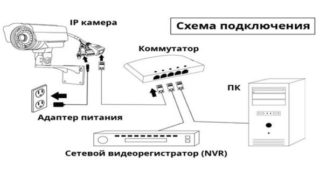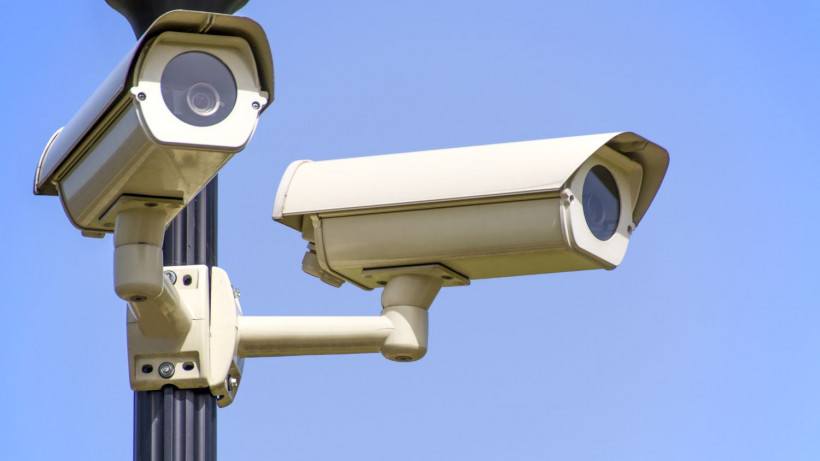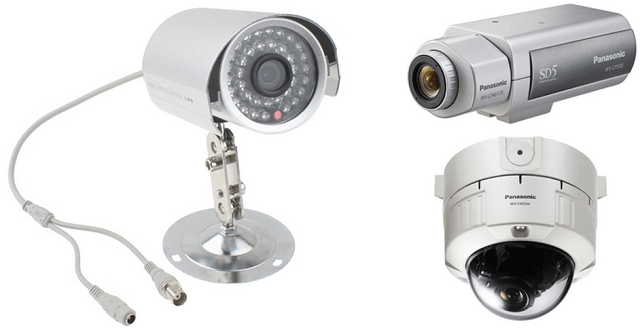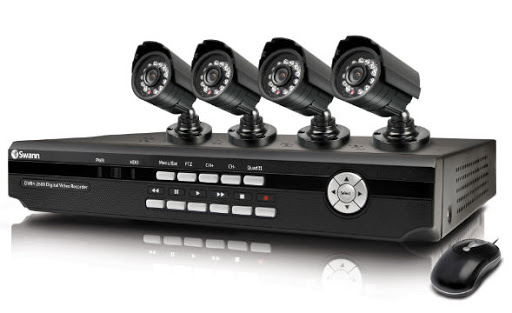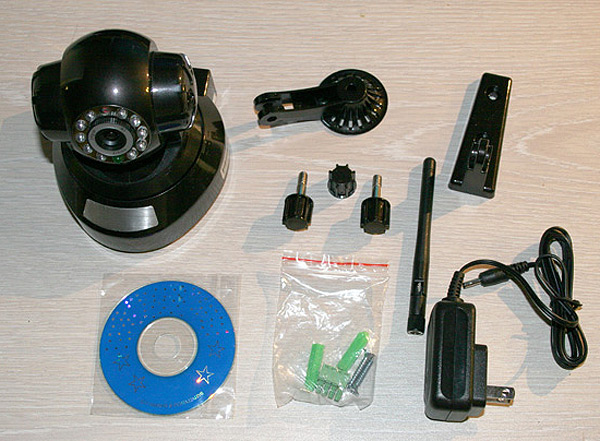Video surveillance systems allow you to receive visual and audio information, being at a certain distance from the observation site. IP video surveillance makes it possible to view data from cameras from any point where there is an Internet connection.
- IP camera definition and working principle
- Differences between an IP camera and an analog one
- Connection and installation of IP video surveillance
- Camera pinout
- Connection diagram
- Connecting directly to a laptop and via a browser
- Common IP Camera Resolution
- Configuring an IP CCTV Camera
- Rating of the best IP cameras for video surveillance
IP camera definition and working principle
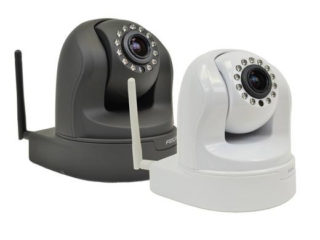
IP CCTV cameras are often called network cameras because they capture video in digital format and use a computer network for broadcasting, transmitting data through the nodes of the local computer network to the end user over great distances. Modern IP cameras have high resolution and are equipped with various additional functions:
- translation of the image into the desired format;
- scaling;
- incline;
- pan;
- intelligent image analysis, in particular face recognition;
- Motion Detection;
- audio tracking;
- automatic alerts.
The network camera has its own IP address, so it can be found through a computer on the local network.
Network devices differ in the type of execution:
- Hull - have a sealed casing that protects from the influence of the external environment.
- Boxed multimedia - installed indoors, equipped with a microphone and a slot for a flash card.
- Dome - provide a 360 ° view, usually installed indoors on the ceiling, there are also outdoor devices.
- Rotary - used to track an object, change the angle of view, equipped with a zoom.
- Cylindrical - universal, installed inside and outside.
The first IP video camera was created in 1996. It had a resolution of only 0.3 megapixels and at that time could not compete with analog systems.
Differences between an IP camera and an analog one
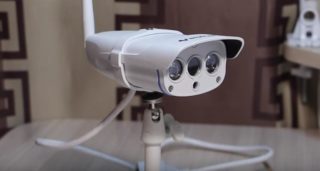
Analog and IP cameras find their customers. The choice between analog and IP equipment is fundamental, because these devices differ significantly from each other, have objective advantages and disadvantages.
A classic analog camera is characterized by a low resolution. Video is transmitted over the cable as a low-frequency signal. Benefits:
- work does not depend on the degree of illumination;
- perform better when shooting on the move;
- unlimited bandwidth;
- not susceptible to hacker attacks.
When choosing systems based on analog cameras, you should be prepared for the following disadvantages:
- limited recording duration;
- analogue interference arising from the influence of an electromagnetic field (the longer the cable, the more interference);
- poor image quality;
- problems with storing a large number of videos.
Gradually, classic devices are replacing video cameras, which are also intended for analog surveillance, but have a high resolution. At the moment there are three standards: AHD, CVI, TVI. The differences between them are minimal, but they are not compatible with each other:
- The video signal of the TVI standard transmits a picture with a resolution of up to 1920 × 1080 pixels. The main difference is the separation of the luminance and chrominance signal for a clearer image.
- CVI translates to High Definition Composite Video Interface. The video signal is also transmitted over coaxial cable. The technology is controlled by Dahua.
- An AHD camera transmits an image that is geometrically close to a digital signal, and the frame size is 1280 × 720 pixels.
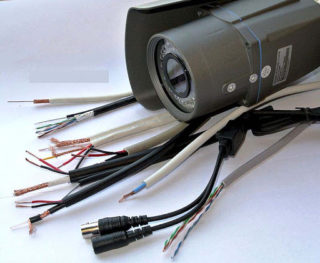
Analog cameras have the following advantages:
- It is easier to connect, because they do not require network settings, network bandwidth calculation, connection to a router, switches. When connecting AHD equipment, you can use the old cable route left over from the classic analog system, you just need to change the cameras and the recorder.
- There are no delays or freezes during signal transmission. In real time, video from analog devices is broadcast at 25 frames per second, so the picture is smooth.
- If a high-quality cable is used for laying the route, the video signal is transmitted without interference and amplifiers over a distance of 500 m, and with the help of active-type transceivers, the transmission distance can be increased up to 1500 m.
- AHD equipment from different manufacturers is compatible with each other due to a single standard.
- At night, analog cameras shoot better video because they have a higher light sensitivity than IP cameras.
With AHD cameras, it is possible to create an analog type system with image quality close to that of IP systems, while avoiding complex setup. If necessary, AHD cameras are connected to an analog video recorder, having previously switched them to the PAL standard analog video surveillance mode.

IP cameras are more expensive, but this does not stop those who value the advantages of an IP video surveillance system:
- IP cameras are much more functional than analog devices. They can be integrated into a general security system, which also includes an access control management system, a fire safety system.
- Advanced IP cameras allow you to recognize faces, license plates, take screenshots, and send notifications when an object is lost from a specified area.
- So far, only network equipment has super-high resolution. If the absolute maximum for analog devices is 3 megapixels, then network cameras can be with a resolution of 10-12 megapixels and even higher. Their installation is justified where high image detail is required.
- Select models can shoot at an increased frame rate, provide a 360 ° view, without blind spots.
- A network video surveillance system is installed on the basis of a computer or video recorder. The latter is optional.
- Since to connect IP cameras that support POE technology, a network cable is used that simultaneously transmits video and audio signals, power supply, no additional lines are required.
- An NVR is significantly cheaper than a hybrid NVR. Devices only for connecting analog cameras are no longer produced.
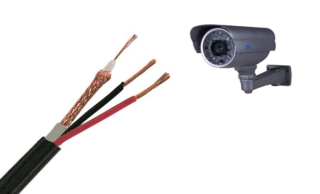
The disadvantages of networking equipment are:
- Low light sensitivity and color quality.
- In the case of IP cameras, the transmission range is no more than 100 meters, provided that a high-quality copper cable with a core thickness of at least 0.5 mm is used. If you lay a copper-plated aluminum network cable in cold conditions, the transmission distance is reduced to 25-30 m. To broadcast the signal over long distances, it is necessary to use switches that retransmit the signal.
- High-definition IP equipment does not always transmit video at 25 frames per second, often only 17 frames per second or lower, so the video sequence is more “ragged”. In addition, delays in image transmission of 1–2 seconds are common.
- Connecting an IP camera can be a difficult or even impossible task for a person who is not well versed in computer technology.
- Using devices from different manufacturers in the system can be fraught with various disruptions in operation, for example, lack of sound recording.
The most popular resolutions: 1 Mp, 1.3 Mp, 2 Mp are provided by both network and analog equipment.
Connection and installation of IP video surveillance
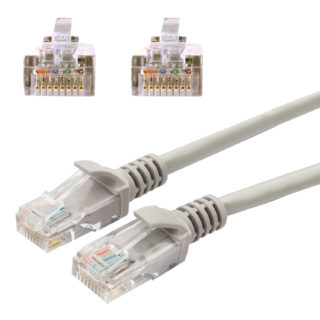
Connecting and installing a network camera are tasks that require specialized skills and knowledge. Users have to turn to specialists because of problems arising in the process.
Camera pinout
Cameras are connected using special patch cords. It may be included in the kit. Crimping the cable is performed using a special crimping tool - a crimper. It is important to observe the pinout.
A cable with pinout according to the T568A standard is used to connect a switch or modem to a computer. When the terminal is located with the flat side down, the diagram is read from right to left:
- white and green;
- green;
- white and orange;
- blue;
- white and blue;
- Orange;
- white-brown;
- brown.
To connect two computer devices via a network card, the T568B standard is used. The diagram is also read from right to left:
- white and orange;
- Orange;
- white and green;
- blue;
- white and blue;
- green;
- white-brown;
- brown.
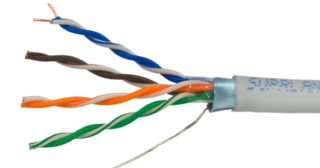
An 8-core UTP - twisted pair cable is used to connect IP cameras. The insulation is removed from the end of the cable. In the RJ-45 connector, the wires are inserted in the order that corresponds to the T568B standard. Since with a simple internet connection, only 1, 2, 3 and 6 conductors are involved, the free conductors can be used to power the camera, for example, 4 - blue and 8 - brown. In this case, the brown and blue conductors are stripped and fixed in the power connector: brown - in "+", blue - in "-".
If the network camera uses a Wi-Fi connection, only the power cable is needed.
Then the conductors are cut to 1 cm and fixed in the RJ-45 connector in the appropriate color sequence. They are crimped with a crimper.
The ready-made connectors are inserted into the sockets of the IP camera and the wires are routed to the DVR, switch or laptop / computer. The second side of the cable is also crimped according to the diagram and connected to the existing device. The power cable is connected to the power source, making sure to observe the polarity.
Connection diagram
The equipment is interconnected using a twisted pair: UTP, FTS and STP. These varieties differ in the type of shielding. After that, the settings are made for access to cameras and the recorder. Access to viewing video from an IP camera is configured via an Internet browser or client program. The first allows you to remotely view video, but special software is required to control multiple cameras.
Special software has a graphical interface and functionality sufficient for comfortable viewing and analysis:
- rewind;
- viewing in recording;
- changing the frame rate;
- extraction of video materials;
- initiation of recording;
- scaling;
- camera tilt.
Popular free software products include:
- XProject Go;
- Zone Minder;
- Axxon Next;
- Xeoma.
Sometimes the software comes with the camera on a disc.
Connecting directly to a laptop and via a browser
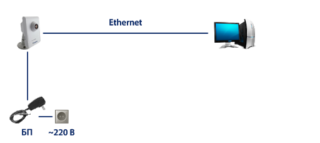
The IP camcorder can be directly connected to a laptop or PC because it has its own web server. However, at most one camera can be used and the LAN port will be occupied. If you connect to the Internet via Wi-Fi, the port can be used to connect an IP camera.
You will need:
- camera;
- complete power supply;
- twisted pair cable.
The video camera comes with a connecting cord with a through pinout (patch cord). One side is crimped according to the 568A scheme, the other - according to 568B. The end of the patchcord is inserted into the RJ-45 connector and the other into the laptop / computer. A power supply is connected to the camera and plugged into an outlet.
The IP address of the camera is set by default. It can be indicated in the instructions, on the box, on a sticker. It can be changed via a web browser. The laptop and the device must be on the same subnet. This means that the digits of the IP address, except for those following the last dot, must match. To change the default IP, you need to open the "Network and Sharing Center", then go to the "Status" tab and go to "Properties". Any subnet address can be specified in the properties of the Internet Protocol Version 4 (TCP / IPv4) component. Sometimes the port is separately indicated with a colon.
To check the connection, you need to enter the address of the IP camera into the address bar of the web browser. If there is a connection, the system will require you to enter a username and password to view the image. Next, a special software for video recording is installed. Thus, the video from the IP camera can be viewed from any device that connects to the Internet through a standard web browser. The address line contains the IP address and port number.
Common IP Camera Resolution
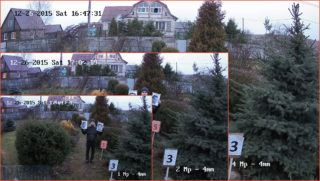
Choosing the resolution of an IP camera, you need to clearly understand whether there will be any benefit from an ultra-detailed picture. A 12MP network camera can be purchased, but the aspect ratio of 16: 9 is only 1MP and 2MP, respectively, 1280 × 720 pixels and 1980 × 1080 pixels. Higher-resolution cameras transmit pictures in a 4: 3 aspect ratio, so in fact, video from a 4-megapixel camcorder may look worse on the same screen than video from a 2-megapixel device. All other things being equal, the higher the resolution, the more informative the image.
Don't rely on simple specifications. To assess the quality of the video, it is worth watching a demo recording made by a specific model. If the resolution is increased by the processor, it is actually Full HD, but the image quality is poor.
Configuring IP CCTV Camera

The quality of the video stream from the IP camera can be configured. For the MJPEG format, the parameters are adjustable: resolution, frame rate, quality. For MPEG-4 and H.264 - resolution, bit rate, quality. The frame rate is the number of frames per unit of time, and the bit rate is determined by the amount of bandwidth. The higher these values are, the smoother the video will be and the more the video files will "weigh". However, the frame rate is limited by the bandwidth, so you shouldn't overestimate these parameters. For smooth footage, a frame rate of 24 frames per second is sufficient, if this characteristic does not matter, you can use professional recommendations:
- box office - 12-15 fps;
- corridors of schools and offices - 5 fps;
- parking - 1-3 frames / s;
- stadiums in the absence of competition - 1 fps.
The required frame rate depends on the speed and direction of movement of the subject. A high frequency is required when the object is at high speed in the horizontal direction.
Rating of the best IP cameras for video surveillance
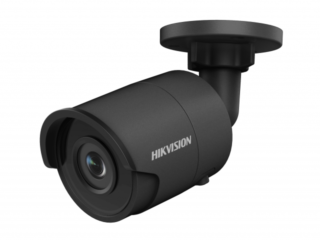
IP cameras can be designed for indoor and outdoor monitoring, and since the requirements for different conditions of use differ, it is necessary to divide the rating of video cameras for outdoor and indoor video surveillance.
TOP 3 outdoor IP cameras:
- Hikvision DS-2CD2023G0-I. The camera is well protected from moisture and dust. The protection level is IP67. There are built-in motion sensors, infrared illumination with a range of 30 m. The shooting speed is 25 frames / s. Resolution - 1920 × 1080 pixels. The only drawback is not the smallest cost.
- Dahua DH-IPC-HDBW1431EP-S-0360B. Outdoor dome camera operating from –30 ° C to + 60 ° C. The main advantages: high resolution - 2688 × 1520 pixels, IP67 protection, infrared illumination and the cost is less than that of the leader of the rating.
- TRASSIR TR-D3111IR1. An inexpensive but decent camera with a resolution of 1280 × 960 pixels. There is a built-in microphone, the level of protection is IP66. Moreover, the quality of shooting in low light is quite good.
TOP-3 IP cameras for indoor video surveillance:
- EZVIZ C6T. High quality mid-range camera with Wi-Fi. Differs in miniature, built-in microphone and speaker. Added the ability to configure via a smartphone. The image is high-quality: rich and clear, but the frame rate is only 15 fps.
- Xiaomi Mi Home Security Camera Basic 1080P. A budget home camera with a wide range of functions with a viewing angle of 130 ° and a good image. The only drawback is the poor quality microphone.
- TRASSIR TR-D7111IR1W. An inexpensive model of a home camera that can work as a baby monitor. It functions both in low light levels and in night mode with IR illumination. The only disadvantage is the setting, which requires certain skills.
It is necessary to select the video surveillance system according to the needs, taking into account the initial conditions.
IP cameras make up a significant part of the video surveillance equipment market. These are devices that allow you to monitor an object over the Internet. Despite the development of AHD technology, network equipment has no analogues.

